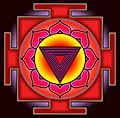Devi facts for kids
Devi is a word in Hinduism that means "goddess". It's like the female version of a god. The male word is Deva. Devi is also known as Shakti, which means the divine female power.
Devi appears in many different forms, called incarnations. Some of her well-known forms are Saraswati, Lakshmi, Durga, Kali, and Parvati. People who especially worship Devi are called 'Shaktas'.
Many Hindus believe in millions of goddesses. Each goddess has her own unique story and appearance. Some goddesses can even change how they look. Some wise people believe that all Hindu goddesses are actually different forms of one main, supreme goddess. Others think that worshipping goddesses shows respect for women.
Contents
Discovering Ancient Goddesses
Early Indus Valley Civilizations
The Indus Valley Civilization was a very old culture in Ancient India. It existed from about 3000 to 1500 BC. Archeologists have found small female figures from this time. Some experts believe these figures show that people back then worshipped goddesses. They think it might have been a "mother goddess," similar to those worshipped in the Mediterranean region.
Goddesses in the Vedic Period
The Vedic period was another ancient time in India. The Vedas, which are sacred texts, mention many goddesses. Some of these goddesses include Ushas, Prithivi, Aditi, Saraswati, Vac, Nirrti, and Ratri. Other names like Puramdhi, Parendi, Raka, Dhisana, Ila, Bharati, Mahi, and Hotra are also found.
Today, some important Hindu goddesses are Lakshmi, Parvati, Sita, Radha, Durga, Kali, and Mahadevi. There are also many others, like the Matrakas, Tara, and Mahavidyas. Some goddesses are even linked to specific places and rivers.
Different Forms of Devi
Durga: The Powerful Warrior Goddess
Durga is one of the most powerful Hindu goddesses. Hindu stories say that Durga was created to fight and defeat asuras, who are demons. Male gods could not control these demons, so they created Durga. She has the combined powers of all the male gods. Durga is mainly seen as a strong, fighting form of Parvati. She is often shown riding a tiger or a lion.
Saraswati: Goddess of Knowledge and Arts
Saraswati is the goddess of speech, learning, science, arts, and music. The Vedas mention her. She is often pictured holding a book, a rosary, a pot of water, and a lute. Saraswati is sometimes seen as a daughter of Parvati or Durga. There was also an ancient river called the Saraswati River, which dried up long ago. This river was also considered a form of the goddess. Saraswati is also the wife of Brahma, the god of knowledge.
Lakshmi: Goddess of Wealth and Good Fortune
Lakshmi, also known as Sri, is a very important Hindu goddess. She represents everything good and prosperous in the world. Lakshmi is seen as the power behind Lord Vishnu, helping him protect the world. Like Vishnu, Lakshmi has many forms, including Sita, Radha, and Rukmini. She is also worshipped as the goddess of wealth and good luck.
Parvati: The Mountain Daughter
Parvati is a goddess who is the second wife of Shiva, one of the three main Hindu gods. In Sanskrit, Parvati means "daughter of the mountains," referring to the Himalayas. She has two sons, Ganesh and Kartikeya. She is also called Gauri. Durga, Kali, and Bharat Mata (Mother India) are popular forms of Goddess Parvati.
Kali: The Dark and Powerful Goddess
Kali is a very powerful Hindu goddess. She is sometimes called Chandi. Durga and Kali fought and defeated many asuras (demons) who troubled humans. Kali is a form of Durga that appeared during Durga's battle with the demon Raktabija. This demon's blood created new demons when it touched the earth. To stop this, Kali drank every drop of blood until Raktabija was defeated.
Kali's name has two meanings: "dark," which means she represents the void, and "time," which destroys everything. She is considered the highest form of the Supreme.
Sati: The First Form of Divine Power
Sati is a Hindu goddess and the first form of divine power, or Shakti. She was the daughter of Dakshya-raj and the first wife of Lord Shiva. After Sati's death, Shiva carried her body and danced. Lord Vishnu then used his Sudarshana Chakra to cut Sati's body into 51 pieces. These pieces fell at 51 different places in the Indian subcontinent, which are now called 51 Shakti Peeths. Many forms of Shakti, like Durga, Kali, and Kamakshya, are worshipped at these places.
Bhuvaneswari: Mother of the Universe
The idea of Goddess Bhuvaneswari as the supreme goddess shows how powerful female deities are in India. Throughout history, goddesses have been seen as the mother of the universe. Their powers create and destroy the universe. The belief in Bhuvaneswari shows how different goddesses, even with their unique personalities, all carry the power of the universe.
Other Important Goddesses
Sita: The Ideal Wife
Sita is one of the most popular Hindu goddesses, especially in North India. She is an avatar (a form) of Lakshmi. Sita was married to Rama, who is an avatar of Vishnu. Hindu scriptures say that Vishnu and Lakshmi are husband and wife.
Radha: Goddess of Love and Devotion
The word Radha means riches and success. Her name is often linked with Krishna, another avatar of Vishnu. Some Hindu scriptures describe her as a form or avatar of goddess Lakshmi.
Related pages
- Hindu Goddesses: Vision of the Divine Feminine in the Hindu Religious Traditions (ISBN: 81-208-0379-5) by David Kinsley
- The Rise of the Goddess in the Hindu Tradition (ISBN: 0-7914-2112-0) by Tracy Pintchman
Images for kids
-
A sculpture of the goddess Lakshmi
-
Yantra are used as icons for Devi in Tantra; above is Tripura-Bhairavi yantra
See also
 In Spanish: Deví para niños
In Spanish: Deví para niños








